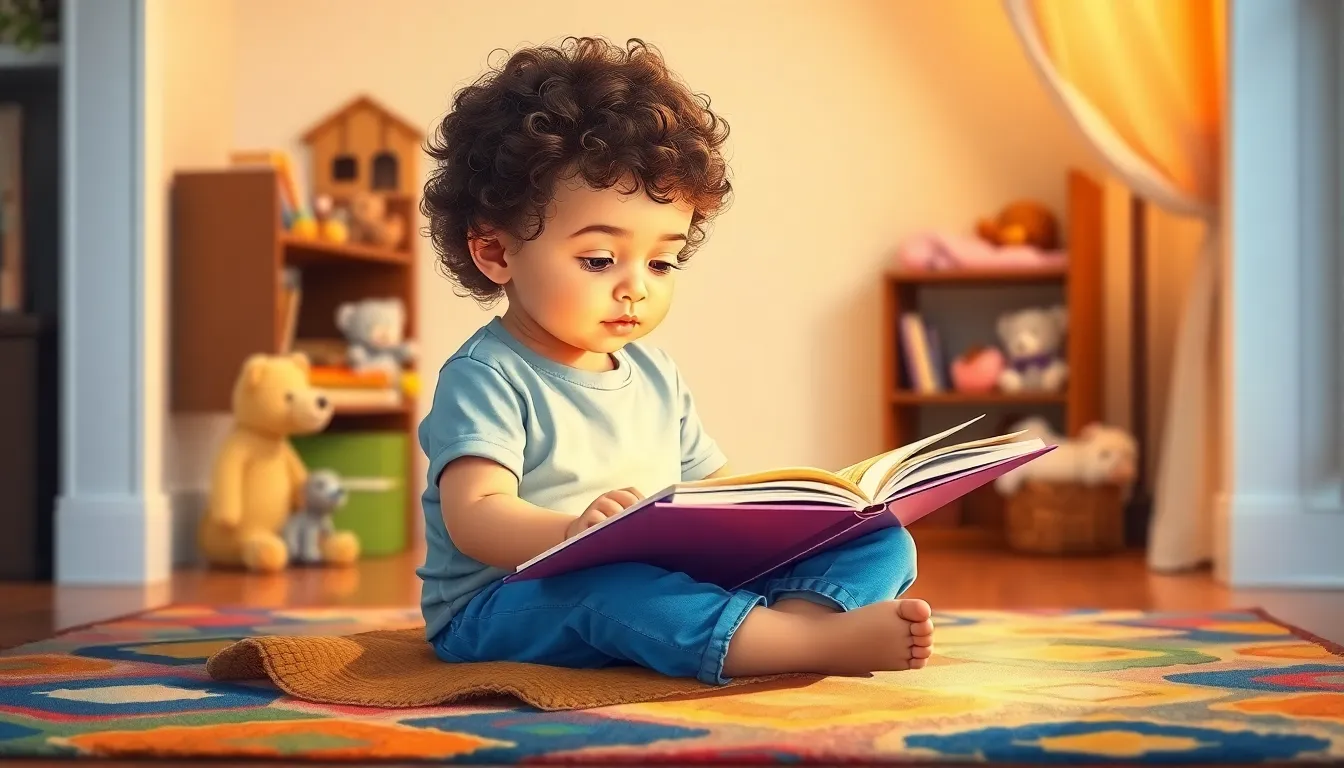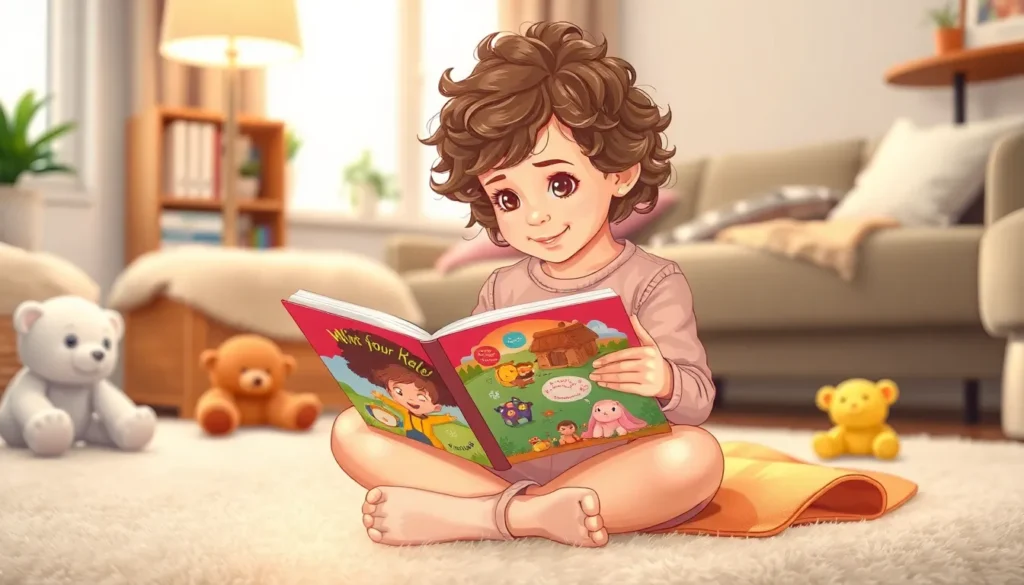In a world where screens dominate, children’s books remain a magical gateway to imagination. These colorful pages not only entertain but also teach valuable lessons, spark creativity, and foster a love for reading that can last a lifetime. Imagine a child curled up with a book, eyes wide with wonder, as they embark on adventures with talking animals and brave heroes. It’s a scene that never gets old.
Table of Contents
ToggleWhat Are Children Books?
Children’s books encompass a wide range of literature designed specifically for young readers. These books include picture books, early readers, chapter books, and middle-grade novels, each catering to different age groups and reading abilities. Imagination thrives within these pages, as they foster creativity and wonder.
Picture books often feature vibrant illustrations paired with simple texts, making them ideal for toddlers and preschoolers. Early readers bridge the gap between pictures and text, helping children develop their reading skills. Chapter books target children who have gained confidence in reading, offering more complex narratives and character development. Middle-grade novels introduce themes that resonate with preteens, addressing their unique experiences.
Educational elements are also significant in children’s literature. Many stories incorporate morals or life lessons, teaching values like friendship, kindness, and perseverance. These aspects contribute to overall emotional and cognitive development. Additionally, children’s books help improve literacy skills while stimulating curiosity about the world.
Diverse representation in children’s literature plays a crucial role in fostering empathy and understanding. When children see characters who reflect their own experiences or offer new perspectives, they learn to appreciate different cultures and backgrounds. Inclusion in storytelling promotes acceptance and broad-minded thinking.
Engagement with children’s books can form lifelong reading habits. By encouraging a love for literature in early childhood, parents and educators set the foundation for academic success. Thus, children’s books serve as vital resources, enriching young minds while adapting to the evolving needs of readers.
Importance of Children Books

Children’s books play a vital role in shaping young minds. They support cognitive growth and emotional development, ensuring children flourish during crucial early years.
Cognitive Development
Reading fosters critical thinking skills in children. Engaging with various narratives improves vocabulary and comprehension, enhancing language skills at an early age. Books encourage imagination, allowing children to visualize and interpret stories uniquely. They present opportunities for problem-solving through character challenges and storylines. Exposure to diverse genres stimulates curiosity and a love for learning. When children read consistently, they build neural connections essential for later academic success. Studies show that children who engage with books exhibit higher test scores and greater environmental awareness.
Emotional Growth
Books nurture emotional intelligence in children. They introduce feelings through relatable characters, helping kids understand and navigate their emotions. By exploring themes of kindness, courage, and friendship, literature promotes empathy and social skills. Readers learn to identify with others’ experiences, aiding in the development of compassion and tolerance. Stories that portray diverse backgrounds enhance acceptance of differences, fostering a positive outlook. Connecting with a character’s journey helps children articulate their feelings, leading to increased self-awareness and resilience. In turn, this emotional foundation benefits relationships with peers and adults.
Types of Children Books
Children’s books include various genres that cater to different age groups, interests, and reading levels.
Picture Books
Picture books engage young readers through illustrations and simple narratives. They’re perfect for toddlers and preschoolers, combining vivid art with text to convey stories. Often, these books introduce basic concepts like colors and numbers. Readers explore emotions and imagination through their pages, making them a beloved choice for bedtime stories. Many picture books feature recurring characters that offer comforting familiarity, fostering a sense of wonder in children as they discover new adventures.
Chapter Books
Chapter books bridge the transition from picture books to more complex narratives. Typically aimed at early elementary-aged children, these books mix illustrations with chapters, helping them develop independent reading skills. Engaging stories often center on relatable characters facing everyday challenges, allowing young readers to connect. Various themes, such as friendship and bravery, appeal to diverse interests. With age-appropriate vocabulary and sentence structure, chapter books lay a foundation for greater reading comprehension and enjoyment.
Young Adult Novels
Young adult novels target teenagers and address themes relevant to their experiences. This genre often explores relationships, identity, and societal issues, aligning with the interests of older children and young teens. Characters in these stories face real-life challenges, prompting readers to reflect on their own lives. Diverse perspectives enhance the relatability of these narratives, expanding understanding of different cultures and situations. Young adult novels play an essential role in shaping critical thinking skills and encouraging empathy among adolescent readers.
Popular Children Books to Consider
Many popular children’s books resonate with young readers across generations. These selections capture imagination and impart valuable lessons through engaging narratives and relatable characters.
Timeless Classics
Timeless classics include “Charlotte’s Web” by E.B. White, a story demonstrating friendship and loyalty through a pig and a spider’s bond. “The Very Hungry Caterpillar” by Eric Carle captivates toddlers with its colorful illustrations and simple text about transformation and growth. “Where the Wild Things Are” by Maurice Sendak invites children to explore emotions and the imagination’s vastness. These books have stood the test of time, enriching the literary landscape and fostering a love for reading.
Contemporary Favorites
Contemporary favorites such as “Dog Man” by Dav Pilkey entertain with humor and action, appealing to early readers. “The Pigeon Finds a Hot Dog!” by Mo Willems delights both children and adults with its playful storyline. “Good Night, Moon” by Margaret Wise Brown remains a bedtime staple, offering comfort through rhythmic prose and soothing illustrations. Engaging stories like these capture the interests of today’s young audiences while promoting literacy and creativity.
Tips for Choosing the Right Children Books
Selecting appropriate children’s books involves understanding various factors that enhance a child’s reading experience.
Age Appropriateness
Books should match the child’s developmental stage. Toddlers benefit from picture books with bright illustrations and simple text. Early readers enjoy stories with a mix of images and straightforward language, promoting engagement with reading. Chapter books serve children who are ready for more complex narratives, easing the transition from pictures to longer text. Middle-grade novels address preteens, tackling themes relevant to their experiences and emotions. Utilizing age-appropriate selections fosters confidence in reading abilities and encourages a lifelong love for literature.
Interests and Themes
Identifying a child’s interests can significantly improve their reading choices. Whether they enjoy adventure, fantasy, or real-life stories, broadening the selection helps maintain engagement. Books featuring relatable characters often resonate more with children. Themes of kindness, friendship, and bravery provide valuable lessons while captivating young readers. Encouraging exploration of diverse genres allows for a richer reading experience, promoting creativity and critical thinking. Ultimately, aligning book choices with interests nurtures a love for reading that lasts a lifetime.
Children’s books are more than just stories; they’re essential tools for growth and development. They spark imagination and creativity while nurturing emotional intelligence and critical thinking. Through diverse characters and engaging narratives, these books help children navigate their feelings and understand the world around them.
Selecting the right books can significantly impact a child’s reading journey. By choosing age-appropriate literature that aligns with a child’s interests, caregivers can inspire a lifelong passion for reading. The magic of children’s books lies in their ability to transport young readers to new worlds while instilling valuable lessons that shape their character and intellect. Embracing this literary adventure opens doors to endless possibilities for every child.

